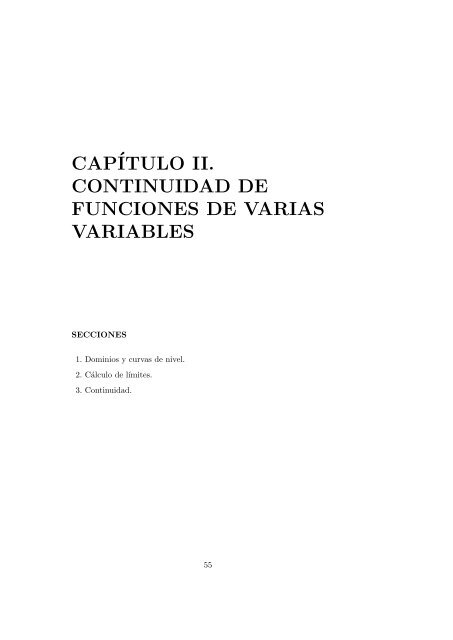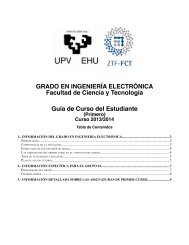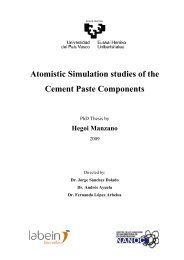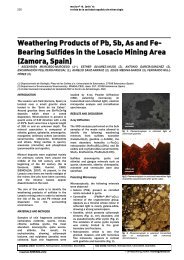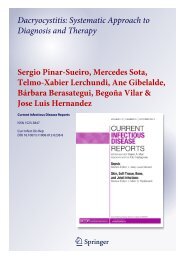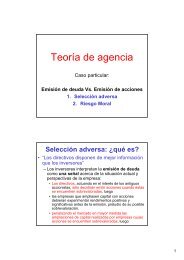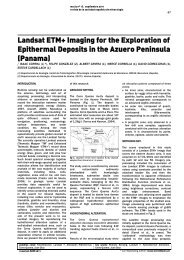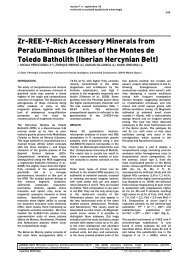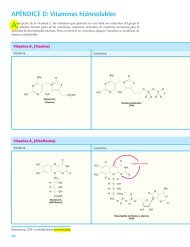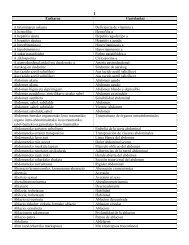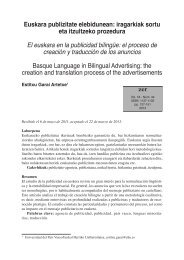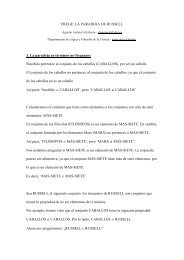Continuidad de funciones de varias variables.
Continuidad de funciones de varias variables.
Continuidad de funciones de varias variables.
Create successful ePaper yourself
Turn your PDF publications into a flip-book with our unique Google optimized e-Paper software.
CAPÍTULO II.<br />
CONTINUIDAD DE<br />
FUNCIONES DE VARIAS<br />
VARIABLES<br />
SECCIONES<br />
1. Dominios y curvas <strong>de</strong> nivel.<br />
2. Cálculo <strong>de</strong> límites.<br />
3. <strong>Continuidad</strong>.<br />
55
1. DOMINIOS Y CURVAS DE NIVEL.<br />
Muchos problemas geométricos y físicos conducen a <strong>funciones</strong> <strong>de</strong> <strong>varias</strong> <strong>variables</strong>.<br />
Por ejemplo, el área <strong>de</strong> un rectángulo viene dado por la función<br />
f(x, y) = xy, don<strong>de</strong> x es la base e y la altura, la distancia <strong>de</strong> un punto<br />
<strong>de</strong>l espacio P = (x, y, z) al origen correspon<strong>de</strong> a la función f(x, y, z) =<br />
x 2 + y 2 + z 2 , etc. De ahí que sea necesario exten<strong>de</strong>r los conceptos y la<br />
teoría <strong>de</strong> <strong>funciones</strong> reales <strong>de</strong> variable real a <strong>funciones</strong> vectoriales <strong>de</strong> <strong>varias</strong><br />
<strong>variables</strong>.<br />
En general, una función vectorial <strong>de</strong> m <strong>variables</strong> f : R m → R n <strong>de</strong>finida<br />
por f(x1, . . . , xm) = (y1, . . . , yn) se escribirá como un vector (f1, . . . , fn) <strong>de</strong><br />
<strong>funciones</strong> fi : R m → R <strong>de</strong>finidas por fi(x1, . . . , xm) = yi (i = 1, . . . , n).<br />
Destacaremos los casos particulares siguientes:<br />
Si n = 1, tenemos una función real <strong>de</strong> m <strong>variables</strong> (que llamaremos campo escalar).<br />
Si m = 1, tenemos una función vectorial <strong>de</strong> una variable (o campo vectorial).<br />
Ejemplos inmediatos <strong>de</strong> ambos casos son las rectas f : R → R 3 en el espacio<br />
tridimensional, <strong>de</strong>finidas por f(t) = (x0, y0, z0) + t(a, b, c), y los planos, que<br />
son <strong>funciones</strong> f : R 2 → R <strong>de</strong>finidas por f(x, y) = ax + by + c.<br />
Los conceptos básicos relativos a propieda<strong>de</strong>s globales <strong>de</strong> estas <strong>funciones</strong> son<br />
los siguientes:<br />
⋄ Dominio <strong>de</strong> f:<br />
⋄ Rango o imagen <strong>de</strong> f:<br />
D(f) = { −→ x = (x1, . . . , xm) ∈ R m : ∃f( −→ x ) ∈ R n }.<br />
R(f) = { −→ y = (y1, . . . , yn) ∈ R n : ∃ −→ x = (x1, . . . , xm) ∈ D(f), f( −→ x ) = −→ y }.<br />
Decimos que una función está acotada cuando su imagen es un conjunto<br />
acotado.<br />
⋄ Gráfica <strong>de</strong> f:<br />
G(f) = {(x1, . . . , xm, y1, . . . , yn) ∈ R m+n : (y1, . . . , yn) = f(x1, . . . , xm)}.<br />
En el caso particular <strong>de</strong> <strong>funciones</strong> f : R 2 → R, es importante <strong>de</strong>stacar el<br />
concepto <strong>de</strong> curvas <strong>de</strong> nivel, que son los conjuntos <strong>de</strong> la forma<br />
Ck = {(x, y) ∈ D(f) : f(x, y) = k},<br />
para valores k ∈ R, pues representan el conjunto <strong>de</strong> puntos <strong>de</strong>l dominio cuya<br />
imagen toma el valor constante k. Como en este caso la gráfica <strong>de</strong> la función<br />
56
es una superficie, las curvas <strong>de</strong> nivel correspon<strong>de</strong>n a los conjuntos <strong>de</strong> puntos<br />
que están a la misma altura <strong>de</strong> dicha superficie; permiten ver las variaciones<br />
<strong>de</strong> altitud en un dominio dado y en algunos casos hacerse una i<strong>de</strong>a <strong>de</strong> la<br />
propia superficie.<br />
Se <strong>de</strong>finen análogamente las superficies <strong>de</strong> nivel en el caso <strong>de</strong> <strong>funciones</strong> f :<br />
R 3 → R como los conjuntos<br />
PROBLEMA 2.1<br />
Sk = {(x, y, z) ∈ D(f) : f(x, y, z) = k}, k ∈ R.<br />
Describir los conjuntos <strong>de</strong> nivel f(x1, . . . , xn) = k, para los valores<br />
<strong>de</strong> k indicados, <strong>de</strong> las siguientes <strong>funciones</strong>:<br />
(a) f(x, y) = x 2 + y 2 , k = 0, 1, 2, 3.<br />
(b) f(x, y) = x 2 + y 2 , k = 0, 1, 2, 3.<br />
(c) f(x, y, z) = x 2 + y 2 , k = 0, 1, 2.<br />
(d) f(x, y) = x 2 − y 2 , k = −2, −1, 0, 1, 2.<br />
(e) f(x, y) = e xy , k = e −2 , e −1 , 1, e, e 2 .<br />
(f) f(x, y) = cos(x + y), k = −1, 0, 1/2, √ 2/2, 1.<br />
Solución<br />
(a) La ecuación x 2 +y 2 = k representa una circunferencia <strong>de</strong> centro el origen<br />
y radio √ k. Las curvas <strong>de</strong> nivel indicadas son entonces las siguientes<br />
(para k = 0, la curva <strong>de</strong> nivel se reduce al punto (0, 0)):<br />
Con esta información po<strong>de</strong>mos <strong>de</strong>ducir que la gráfica tiene la siguiente<br />
forma (se trata <strong>de</strong> un paraboloi<strong>de</strong> <strong>de</strong> revolución):<br />
57
(b) Las ecuaciones x 2 + y 2 = k también representan circunferencias <strong>de</strong><br />
centro el origen, pero <strong>de</strong> radio k, lo que hace que el crecimiento <strong>de</strong><br />
dicho radio con respecto a k sea lineal. Las curvas <strong>de</strong> nivel son:<br />
mientras que la superficie es ahora la <strong>de</strong> un cono:<br />
(c) Como la función es ahora <strong>de</strong> tres <strong>variables</strong>, las ecuaciones x 2 + y 2 = k<br />
son las superficies <strong>de</strong> nivel <strong>de</strong> la función y representan cilindros cuyo<br />
eje es el eje Z y el radio √ k (para k = 0 <strong>de</strong>genera en una recta).<br />
58
(El cilindro exterior no está completo para mayor claridad en la ilustración.)<br />
Observar que la gráfica <strong>de</strong> la función es ahora una región <strong>de</strong>l espacio<br />
R 4 y, por tanto, no es posible su representación gráfica en un plano.<br />
(d) En este caso, las curvas x 2 − y 2 = k representan hipérbolas, cuyo eje<br />
real es el eje X si k > 0 y es el eje Y cuando k < 0 (en el caso<br />
k = 0 <strong>de</strong>genera en las rectas x = y y x = −y). La gráfica es la <strong>de</strong> un<br />
paraboloi<strong>de</strong> hiperbólico y su forma es la siguiente:<br />
(e) Las ecuaciones e xy = k o, en forma equivalente, xy = ln k, también<br />
representan hipérbolas pero en este caso sus asíntotas son los ejes <strong>de</strong><br />
coor<strong>de</strong>nadas (salvo el caso k = 1 que <strong>de</strong>genera en las rectas x = 0 e<br />
y = 0). Las curvas <strong>de</strong> nivel y la gráfica <strong>de</strong> la función son <strong>de</strong> la forma<br />
que indican las figuras:<br />
59
(f) Observamos que, en este caso, cada curva <strong>de</strong> nivel cos(x + y) = k<br />
produce un número infinito <strong>de</strong> rectas x + y = arc cos k + 2nπ, para<br />
cualquier n ∈ Z. Esto quiere <strong>de</strong>cir que la superficie es periódica (es<br />
<strong>de</strong>cir, si x ′ = x + π, y ′ = y + π, entonces cos(x + y) = cos(x ′ + y ′ )).<br />
No representamos las curvas <strong>de</strong> nivel pues no dan información sobre<br />
la gráfica <strong>de</strong> la superficie pero sí ilustramos la forma <strong>de</strong> la propia<br />
superficie:<br />
60
PROBLEMA 2.2<br />
Dibujar algunas curvas <strong>de</strong> nivel <strong>de</strong> las <strong>funciones</strong> que se indican y<br />
<strong>de</strong>ducir la gráfica <strong>de</strong> las mismas:<br />
(a) f(x, y) = 3x + 2y + 1.<br />
(b) f(x, y) = (100 − x 2 − y 2 ) 1/2 .<br />
(c) f(x, y) = |y|.<br />
<br />
x2 + y2 si x ≥ 0,<br />
(d) f(x, y) =<br />
|y| si x < 0.<br />
Solución<br />
(a) Las curvas <strong>de</strong> nivel f(x, y) = k son las rectas paralelas 3x + 2y = k − 1,<br />
lo que correspon<strong>de</strong> a un plano <strong>de</strong> la forma indicada en la figura.<br />
(b) Si k < 10, las curvas <strong>de</strong> nivel f(x, y) = k son circunferencias centradas<br />
61
en el origen y radio √ 100 − k 2 . La superficie es la esfera centrada en<br />
el origen y radio 10.<br />
(c) Cada curva <strong>de</strong> nivel f(x, y) = k es el par <strong>de</strong> rectas y = k, y = −k, lo<br />
que da lugar a la superficie que se indica en la gráfica.<br />
(d) En este caso, la curva <strong>de</strong> nivel f(x, y) = k está compuesta por el par<br />
<strong>de</strong> semirrectas y = k, y = −k, para x < 0, y la semicircunferencia<br />
x 2 + y 2 = k 2 , para x ≥ 0. Queda por tanto una superficie <strong>de</strong> la forma<br />
indicada en la figura.<br />
62
PROBLEMA 2.3<br />
Hallar los dominios <strong>de</strong> las siguientes <strong>funciones</strong>:<br />
(a) f(x, y) = 1 − x 2 − y 2 .<br />
(b) f(x, y) = √ x 2 − 4 + 4 − y 2 .<br />
(c) f(x, y) = √ y sen x.<br />
(d) f(x, y, z) = ln(x/yz).<br />
Solución<br />
(a) El dominio será el conjunto {(x, y) ∈ R 2 : 1 − x 2 − y 2 ≥ 0} (<strong>de</strong>bido a la<br />
existencia <strong>de</strong> una raíz cuadrada). Esto es equivalente a la <strong>de</strong>sigualdad<br />
x 2 + y 2 ≤ 1, <strong>de</strong> modo que<br />
D(f) = {(x, y) ∈ R 2 : x 2 + y 2 ≤ 1},<br />
que es precisamente la bola unidad.<br />
(b) Para que existan ambas raíces cuadradas, <strong>de</strong>be verificarse simultáneamente<br />
que<br />
x 2 − 4 ≥ 0 y 4 − y 2 ≥ 0,<br />
sistema que, al resolver, da como solución |x| ≥ 2, |y| ≤ 2. Entonces<br />
D(f) = {(x, y) ∈ R 2 : |x| ≥ 2, |y| ≤ 2},<br />
cuya gráfica es la <strong>de</strong> la figura adjunta:<br />
63
(c) En este caso, los puntos <strong>de</strong>l dominio <strong>de</strong>ben verificar la inecuación<br />
y sen x ≥ 0, la cual se <strong>de</strong>scompone en las dos siguientes:<br />
y ≥ 0 , sen x ≥ 0<br />
y ≤ 0 , sen x ≤ 0,<br />
es <strong>de</strong>cir, para los valores <strong>de</strong> x don<strong>de</strong> sen x ≥ 0, están en el dominio los<br />
puntos <strong>de</strong>l semiplano superior y, para los valores <strong>de</strong> x don<strong>de</strong> sen x ≤ 0,<br />
están en el dominio los puntos <strong>de</strong>l semiplano inferior. La gráfica es la<br />
siguiente:<br />
(d) Para que un punto (x, y, z) esté en el dominio, <strong>de</strong>be verificarse que<br />
x/(yz) > 0, lo que equivale al siguiente conjunto <strong>de</strong> <strong>de</strong>sigualda<strong>de</strong>s:<br />
x > 0 , y > 0, z > 0<br />
x > 0 , y < 0, z < 0;<br />
x < 0 , y > 0, z < 0;<br />
x < 0 , y < 0, z > 0.<br />
Este sistema está formado por los octantes primero, tercero, sexto y<br />
octavo <strong>de</strong> la superficie R 3 .<br />
64
PROBLEMA 2.4<br />
Sea f : R 2 → R 2 la función <strong>de</strong>finida por f(x, y) = (2x, y + 1). Si<br />
llamamos A = [0, 1] × [0, 1] y B = {(x, y) ∈ R 2 : x 2 + y 2 ≤ 1}, calcular<br />
f(A), f(B), f −1 (A) y f −1 (B).<br />
Solución<br />
(a) Para calcular f(A), tomemos un punto (x, y) ∈ A. Entonces<br />
<br />
0 ≤ x ≤ 1 0 ≤ 2x ≤ 2<br />
=⇒<br />
=⇒ f(x, y) ∈ [0, 2] × [1, 2],<br />
0 ≤ y ≤ 1 1 ≤ y + 1 ≤ 2<br />
<strong>de</strong> modo que f(A) = [0, 2] × [1, 2].<br />
Análogamente, si (x, y) ∈ B y llamamos (u, v) = f(x, y), entonces<br />
u = 2x, v = y+1 =⇒ u/2 = x, v−1 = y =⇒ (u/2) 2 +(v−1) 2 = x 2 +y 2 .<br />
Así pues, si x 2 +y 2 ≤ 1, u2<br />
4 + (v − 1)2 ≤ 1, que correspon<strong>de</strong> a la región<br />
limitada por la elipse <strong>de</strong> la figura.<br />
65
f(B)<br />
(b) Calculemos a continuación las imágenes inversas <strong>de</strong> los conjuntos A y<br />
B. Por <strong>de</strong>finición, dado cualquier conjunto G,<br />
f −1 (G) = {(x, y) ∈ R 2 : f(x, y) ∈ G}.<br />
En particular, f −1 (A) = {(x, y) ∈ R 2 : (2x, y + 1) ∈ A}. Resulta así:<br />
0 ≤ 2x ≤ 1 =⇒ 0 ≤ x ≤ 1/2<br />
0 ≤ y + 1 ≤ 1 =⇒ −1 ≤ y ≤ 0<br />
<strong>de</strong> modo que f −1 (A) = [0, 1/2] × [−1, 0].<br />
f −1 (A)<br />
Análogamente, el conjunto <strong>de</strong> puntos que verifican (2x, y + 1) ∈ B<br />
<strong>de</strong>be cumplir la relación 4x 2 + (y + 1) 2 ≤ 1, y la imagen inversa <strong>de</strong> B<br />
es la región limitada por la elipse <strong>de</strong> la figura.<br />
66
f −1 (B)<br />
67
2. CÁLCULO DE LÍMITES.<br />
Consi<strong>de</strong>remos una función arbitraria f : R m → R n con dominio D(f) = D.<br />
Sean S ⊂ D, −→ x0 ∈ R m , −→ y0 ∈ R n .<br />
Diremos que lím<br />
x→x0<br />
x∈S<br />
S es igual a −→ y0), cuando<br />
f(x) = y0 (en palabras, el límite <strong>de</strong> f en −→ x0 a lo largo <strong>de</strong><br />
∀ε > 0, ∃δ > 0 : f(x) ∈ B(y0, ε), ∀x ∈ (B(x0, δ) \ {x0}) ∩ S.<br />
Equivalentes a este enunciado son los siguientes:<br />
∀ε > 0, ∃δ > 0 : f (B(x0, δ) \ {x0}) ∩ S ⊂ B(y0, ε);<br />
∀ε > 0, ∃δ > 0 : 0 < x − x0 < δ, x ∈ S =⇒ f(x) − y0 < ε.<br />
Esta <strong>de</strong>finición es una simple extensión <strong>de</strong> la <strong>de</strong>finición usual <strong>de</strong> límite <strong>de</strong><br />
una función real don<strong>de</strong> se sustituye la distancia en R (dada por el valor<br />
absoluto) por la distancia en cada uno <strong>de</strong> los espacios métricos R m y R n<br />
(dada por la correspondiente norma euclí<strong>de</strong>a).<br />
Observemos que la <strong>de</strong>finición no tiene sentido si x0 ∈ S ′ pues, en este caso,<br />
(B(x0, δ)\{x0})∩S = ∅ y cualquier punto pue<strong>de</strong> ser el límite <strong>de</strong> una función<br />
en x0. En el caso <strong>de</strong> que S = D, y no haya lugar a confusión, escribiremos<br />
simplemente lím f(x).<br />
x→x0<br />
Enunciamos a continuación las siguientes propieda<strong>de</strong>s básicas <strong>de</strong>l límite.<br />
Teorema 1. Si existe lím<br />
x→x0<br />
x∈S<br />
Teorema 2. Sea T ⊂ S ⊂ D. Entonces<br />
lím<br />
x→x0<br />
x∈S<br />
(ver problemas 2.6 y 2.8).<br />
f(x), este límite es único.<br />
f(x) = y0 =⇒ lím<br />
x→x0<br />
x∈T<br />
f(x) = y0<br />
Teorema 3 (Operaciones algebraicas con el límite.) Dadas dos <strong>funciones</strong><br />
f : D1 ⊂ Rm → Rn y g : D2 ⊂ Rm → Rn , y un conjunto S ⊂ D1 ∩ D2, si<br />
lím f(x) = y1 y lím g(x) = y2, entonces:<br />
x→x0<br />
x∈S<br />
x→x0<br />
x∈S<br />
(a) lím (f + g)(x) = y1 + y2.<br />
x→x0<br />
x∈S<br />
(b) lím (λf)(x) = λy1.<br />
x→x0<br />
x∈S<br />
68
(c) lím f(x) · g(x) = y1 · y2.<br />
x→x0<br />
x∈S<br />
(d) lím<br />
x→x0<br />
x∈S<br />
f(x) = lím f(x)<br />
x→x0<br />
.<br />
Proposición 4. Si <strong>de</strong>scomponemos la función f : D ⊂ R m → R n en sus<br />
componentes f(x) = f1(x), . . . , fn(x) , don<strong>de</strong> cada fi : D → R (1 ≤ i ≤ n),<br />
entonces<br />
lím<br />
x→x0<br />
x∈S<br />
f(x) = (a1, . . . , an) ⇐⇒ lím<br />
x→x0<br />
x∈S<br />
fi(x) = ai, 1 ≤ i ≤ n.<br />
Proposición 5. Dada una función f : R2 → R, si existe lím f(x, y) =<br />
(x,y)→(x0,y0)<br />
L, y existen también los límites <strong>de</strong> una variable lím<br />
x→x0<br />
entonces existen y son iguales los llamados límites iterados<br />
f(x, y) y lím<br />
y→y0<br />
<br />
<br />
<br />
lím<br />
y→y0<br />
lím f(x, y)<br />
x→x0<br />
= lím<br />
x→x0<br />
lím f(x, y)<br />
y→y0<br />
= L.<br />
f(x, y),<br />
[Esta propiedad está <strong>de</strong>mostrada en el problema 2.7]. De esta propiedad se<br />
<strong>de</strong>duce en particular que, si existen los límites iterados pero son distintos,<br />
entonces no existe el límite <strong>de</strong> la función.<br />
Resultados similares se pue<strong>de</strong>n obtener para <strong>funciones</strong> <strong>de</strong> más <strong>de</strong> dos <strong>variables</strong>.<br />
PROBLEMA 2.5<br />
Utilizando la <strong>de</strong>finición <strong>de</strong> límite, <strong>de</strong>mostrar que<br />
Solución<br />
lím (3x − 2y) = 14.<br />
(x,y)→(4,−1)<br />
Se trata <strong>de</strong> probar que, dado cualquier ε > 0, se pue<strong>de</strong> encontrar δ > 0 tal<br />
que<br />
|3x − 2y − 14| < ε cuando d (x, y), (4, −1) < δ.<br />
69
Para ello obtenemos <strong>de</strong> la condición la siguiente ca<strong>de</strong>na <strong>de</strong> <strong>de</strong>sigualda<strong>de</strong>s:<br />
Como<br />
d (x, y), (4, −1) < δ =⇒ (x − 4) 2 + (y + 1) 2 < δ<br />
=⇒ (x − 4) 2 < δ 2 , (y + 1) 2 < δ 2<br />
=⇒ |x − 4| < δ, |y + 1| < δ.<br />
|3x − 2y − 14| = |3(x − 4) − 2(y + 1)| ≤ 3|x − 4| + 2|y + 1|,<br />
<strong>de</strong> lo anterior <strong>de</strong>ducimos que<br />
|3x − 2y − 14| < 3δ + 2δ = 5δ.<br />
Basta pues elegir δ = ε/5 para que |3x−2y−14| < ε cuando d (x, y), (4, −1) <<br />
δ.<br />
PROBLEMA 2.6<br />
Sea f : D ⊂ Rm → Rn , x0 ∈ Rm , y0 ∈ Rn , T ⊂ S ⊂ D. Probar que<br />
lím f(x) = y0 =⇒ lím f(x) = y0.<br />
Solución<br />
x→x0<br />
x∈S<br />
x→x0<br />
x∈T<br />
La hipótesis <strong>de</strong>l problema se traduce, según la <strong>de</strong>finición, en la condición<br />
siguiente:<br />
lím<br />
x→x0<br />
x∈S<br />
f(x) = y0 ⇐⇒ ∀ε > 0, ∃δ > 0 : f S ∩ B ∗ (x0, δ) ⊂ B(y0, ε)<br />
(don<strong>de</strong> B ∗ (x0, δ) representa la bola <strong>de</strong> centro x0 y radio δ excluyendo el<br />
propio punto x0).<br />
Ahora bien, como T ⊂ S, entonces T ∩ B ∗ (x0, δ) ⊂ S ∩ B ∗ (x0, δ) con lo<br />
que<br />
f T ∩ B ∗ (x0, δ) ⊂ f S ∩ B ∗ (x0, δ) ⊂ B(y0, ε).<br />
Luego,<br />
es <strong>de</strong>cir lím<br />
x→x0<br />
x∈T<br />
∀ε > 0, ∃δ > 0 : f T ∩ B ∗ (x0, δ) ⊂ B(y0, ε),<br />
f(x) = y0.<br />
70
En la práctica este resultado es importante puesto que, si elegimos a<strong>de</strong>cuadamente<br />
un subconjunto T ⊂ S (para el que sea fácil el cálculo <strong>de</strong>l límite), una<br />
condición necesaria para que lím f(x) = y0 es que lím f(x) = y0.<br />
x→x0<br />
x∈S<br />
x→x0<br />
x∈T<br />
El recíproco no es cierto, como se comprueba en el problema 2.14.<br />
PROBLEMA 2.7<br />
Se consi<strong>de</strong>ra la función z = f(x, y). Supongamos que existen<br />
lím f(x, y) = L, lím f(x, y) y lím f(x, y). Probar que existe<br />
(x,y)→(x0,y0) x→x0<br />
y→y0<br />
Solución<br />
<br />
lím<br />
y→y0<br />
lím<br />
x→x0<br />
<br />
f(x, y)<br />
= lím<br />
x→x0<br />
<br />
lím<br />
y→y0<br />
<br />
f(x, y) = L.<br />
Probaremos aquí que, si lím f(x, y) = L y lím f(x, y) = G(y),<br />
(x,y)→(x0,y0) x→x0<br />
entonces lím<br />
y→y0<br />
G(y) = L (el otro caso se comprueba <strong>de</strong> forma análoga).<br />
Sea para ello ε > 0 arbitrario. Por hipótesis, existe δ1 > 0 tal que<br />
|f(x, y) − L| < ε/2 si |x − x0| 2 + |y − y0| 2 < δ1.<br />
En particular,<br />
√ √<br />
|f(x, y) − L| < ε/2 si |x − x0| < δ1 2/2 y |y − y0| < δ1 2/2.<br />
La segunda hipótesis indica que también existe δ2 > 0 tal que<br />
|f(x, y) − G(y)| < ε/2 si |x − x0| < δ2.<br />
√<br />
Eligiendo ahora δ = mín{δ1 2/2, δ2}, las dos <strong>de</strong>sigualda<strong>de</strong>s anteriores se<br />
verifican simultáneamente y resulta:<br />
|G(y)−L| = |G(y)−f(x, y)+f(x, y)−L| ≤ |G(y)−f(x, y)|+|f(x, y)−L| < ε<br />
si |y − y0| < δ, lo que prueba que lím G(y) = L.<br />
y→y0<br />
Este resultado nos muestra que para la existencia e igualdad <strong>de</strong> los límites<br />
iterados no es suficiente la existencia <strong>de</strong>l límite <strong>de</strong> la función: hace falta<br />
también la existencia <strong>de</strong> los límites <strong>de</strong> <strong>funciones</strong> <strong>de</strong> una variable. Observemos<br />
a<strong>de</strong>más que el recíproco no es cierto (ver problema 2.12).<br />
71
PROBLEMA 2.8<br />
x<br />
Calcular lím<br />
(x,y)→(0,0)<br />
2 + y2 |x| + |y| .<br />
Solución<br />
En este ejercicio, el dominio <strong>de</strong> la función es S = R 2 \{(0, 0)} y consi<strong>de</strong>ramos<br />
el subconjunto T = {(x, mx) : x ∈ R \ {0}}. Tenemos entonces<br />
x<br />
lím<br />
(x,y)→(0,0)<br />
(x,y)∈T<br />
2 + y2 x<br />
= lím<br />
|x| + |y| (x,mx)→(0,0)<br />
2 + (mx) 2<br />
|x| + |mx|<br />
(1 + m<br />
= lím<br />
x→0<br />
2 )x2 = 0.<br />
(1 + |m|)|x|<br />
De acuerdo con el resultado <strong>de</strong>l problema 2.6, si existiera el límite pedido,<br />
este <strong>de</strong>be ser cero. Debemos probar pues que<br />
∀ε > 0, ∃δ > 0 : 0 < x2 + y2 < δ =⇒ x2 + y2 < ε.<br />
|x| + |y|<br />
En efecto, como |x| ≤ x 2 + y 2 < δ, |y| ≤ x 2 + y 2 < δ y<br />
x2 + y2 |x| + |y| ≤ x2 + y2 + 2|x| · |y|<br />
=<br />
|x| + |y|<br />
(|x| + |y|)2<br />
|x| + |y|<br />
basta elegir δ = ε/2 para que x2 + y2 < ε.<br />
|x| + |y|<br />
= |x| + |y| < 2δ,<br />
Será común en este tipo <strong>de</strong> problemas utilizar trayectorias <strong>de</strong>l tipo y = mx.<br />
Así, si el límite es el mismo para todas ellas, el resultado es un candidato a<br />
ser el límite <strong>de</strong> la función, pero si dicho límite varía con cada trayectoria, la<br />
función no tiene límite.<br />
PROBLEMA 2.9<br />
e<br />
Hallar lím<br />
(x,y)→(0,0)<br />
xy − 1<br />
sen x · ln(1 + y) .<br />
72
Solución<br />
Haciendo u = x · y, po<strong>de</strong>mos escribir<br />
e xy = e u = 1 + u u2<br />
+<br />
1! 2! + · · · = 1 + xy + x2y2 + . . . ,<br />
2<br />
con lo que tenemos la equivalencia entre infinitésimos e xy − 1 ∼ xy.<br />
Teniendo en cuenta las equivalencias ya conocidas para <strong>funciones</strong> <strong>de</strong> una<br />
variable<br />
sen x ∼ x, ln(1 + y) ∼ y,<br />
obtenemos directamente que<br />
e<br />
lím<br />
(x,y)→(0,0)<br />
xy − 1<br />
xy<br />
= lím<br />
sen x · ln(1 + y) (x,y)→(0,0) xy<br />
PROBLEMA 2.10<br />
x + y − 1<br />
Calcular L = lím √ √ .<br />
(x,y)→(0,1) x − 1 − y<br />
Solución<br />
= 1.<br />
Multiplicando numerador y <strong>de</strong>nominador por √ x + √ 1 − y, tenemos:<br />
(x + y − 1)(<br />
L = lím<br />
(x,y)→(0,1)<br />
√ x + √ 1 − y)<br />
= lím<br />
x − 1 + y<br />
(x,y)→(0,1) (√x + 1 − y) = 0.<br />
PROBLEMA 2.11<br />
2xy<br />
Calcular lím<br />
(x,y)→(0,0) x2 .<br />
+ y2 Solución<br />
Si ten<strong>de</strong>mos hacia el origen según la recta y = mx, obtenemos:<br />
lím<br />
(x,y)→(0,0)<br />
y=mx<br />
2xy<br />
x2 = lím<br />
+ y2 x→0<br />
73<br />
2mx2 x2 + m2 2m<br />
= .<br />
x2 1 + m2
Como indica el resultado, este varía según los distintos valores <strong>de</strong> m, lo que<br />
indica que la función dada carece <strong>de</strong> límite en el origen. Sin embargo, es fácil<br />
comprobar que los límites iterados son ambos iguales a cero, lo que muestra<br />
<strong>de</strong> nuevo que la existencia e igualdad <strong>de</strong> los límites iterados no es condición<br />
suficiente para la existencia <strong>de</strong> límite.<br />
En la gráfica <strong>de</strong> las curvas <strong>de</strong> nivel se observa que éstas tien<strong>de</strong>n a cortarse<br />
en el origen, lo que intuitivamente significa que el límite en este punto no<br />
existe.<br />
PROBLEMA 2.12<br />
Probar que f(x, y) =<br />
<br />
sen(1/y)<br />
0<br />
si y = 0<br />
tiene límite cero cuando<br />
si y = 0<br />
(x, y) → (0, 0) pero los límites iterados son distintos. ¿Por qué es<br />
posible esta situación?<br />
Solución<br />
Como lím<br />
y→0 x sen(1/y) no existe, tampoco existe el límite iterado<br />
lím<br />
x→0<br />
<br />
<br />
lím x sen(1/y) .<br />
y→0<br />
Por otra parte, como lím<br />
x→0 x sen(1/y) = 0, también<br />
lím<br />
y→0<br />
<br />
<br />
lím x sen(1/y)<br />
x→0<br />
= 0.<br />
Una <strong>de</strong> las condiciones necesarias para que el límite <strong>de</strong> la función coincida<br />
con los límites iterados es que ambos existan. Como dicha condición no<br />
74
se cumple, no se pue<strong>de</strong> aplicar la propiedad. Sin embargo, en este caso el<br />
límite existe y vale cero, pues dado cualquier ε > 0, basta elegir δ = ε para<br />
que<br />
PROBLEMA 2.13<br />
(x, y) < δ =⇒ |x| < δ, |y| < δ<br />
=⇒ |x sen(1/y)| ≤ |x| < δ<br />
=⇒ |f(x, y) − 0| < ε.<br />
Hallar los siguientes límites o justificar su existencia:<br />
x<br />
(a) lím<br />
(x,y)→(0,0)<br />
2 − y2 x2 .<br />
+ y2 (b) lím<br />
(x,y)→(0,2)<br />
sen(xy)<br />
.<br />
x<br />
(c) lím<br />
(x,y)→(0,0) (x2 + y 2 ) sen 1<br />
xy .<br />
x|y|<br />
(d) lím <br />
(x,y)→(0,0) x2 + y2 .<br />
Solución<br />
(a) Calculemos en primer lugar los límites iterados:<br />
<br />
x<br />
lím lím<br />
y→0 x→0<br />
2 − y2 x2 + y2 <br />
<br />
x<br />
lím lím<br />
x→0 y→0<br />
= lím(−1)<br />
= −1;<br />
y→0 2 − y2 x2 + y2 <br />
= lím 1 = 1.<br />
x→0<br />
75
Deducimos <strong>de</strong> este resultado que no existe el límite propuesto.<br />
Las gráficas siguientes muestran diferentes curvas <strong>de</strong> nivel <strong>de</strong> la función<br />
(las cuales tien<strong>de</strong>n a cortarse en el origen) y la forma <strong>de</strong> la superficie,<br />
don<strong>de</strong> se pue<strong>de</strong> comprobar intuitivamente que el límite buscado no<br />
existe.<br />
(b) Comprobemos nuevamente la existencia <strong>de</strong> los límites iterados:<br />
<br />
sen(xy)<br />
<br />
lím lím<br />
y→2 x→0 x<br />
<br />
sen(xy)<br />
<br />
lím lím<br />
x→0 y→2 x<br />
=<br />
=<br />
lím y = 2;<br />
y→2<br />
sen(2x)<br />
lím = 2.<br />
x→0 x<br />
Para comprobar que, efectivamente, el límite <strong>de</strong> la función es 2, aplicamos<br />
el teorema <strong>de</strong> la función intermedia. Como<br />
y cos(xy) ≤ sen(xy)<br />
≤ y si x > 0,<br />
x<br />
y ≤ sen(xy)<br />
≤ y cos(xy) si x < 0,<br />
x<br />
y las dos <strong>funciones</strong> <strong>de</strong> los extremos tienen límite 2 cuando (x, y) →<br />
(0, 2), resulta que la función propuesta también tiene límite 2.<br />
(c) Al igual que en el apartado anterior, <strong>de</strong>bido a que<br />
−(x 2 + y 2 <br />
<br />
) ≤ <br />
(x2 + y 2 ) sen 1<br />
<br />
<br />
<br />
xy ≤ x2 + y 2 ,<br />
76
y como el límite <strong>de</strong> ambos extremos es cero, la función propuesta tiene<br />
límite cero en el origen. Observemos sin embargo que no existen los<br />
límites iterados.<br />
(d) Calculamos en primer lugar los límites iterados:<br />
<br />
lím lím<br />
y→0 x→0<br />
lím<br />
x→0<br />
<br />
lím<br />
y→0<br />
x|y|<br />
<br />
<br />
x2 + y2 x|y|<br />
<br />
<br />
x2 + y2 = lím<br />
y→0 0 = 0;<br />
= lím<br />
x→0 0 = 0.<br />
Para <strong>de</strong>mostrar que, efectivamente, el límite es cero, utilizamos la siguiente<br />
<strong>de</strong>sigualdad:<br />
(|x| − |y|) 2 ≥ 0 =⇒ x 2 + y 2 − 2|xy| ≥ 0 =⇒ 2|xy| ≤ x 2 + y 2<br />
=⇒<br />
=⇒ −<br />
|xy|<br />
x 2 + y 2 ≤<br />
x 2 + y 2<br />
2<br />
x 2 + y 2<br />
≤<br />
2<br />
x|y|<br />
x 2 + y 2 ≤<br />
x 2 + y 2<br />
Nuevamente, los límites <strong>de</strong> las <strong>funciones</strong> en los extremos son iguales a<br />
cero, por lo que el límite <strong>de</strong> la función propuesta también es cero.<br />
PROBLEMA 2.14<br />
Hallar lím f(x, y) si f(x, y) =<br />
(x,y)→(0,0)<br />
Solución<br />
<br />
0 si y ≤ 0 ó y ≥ x2 1 si 0 < y < x2 .<br />
En la gráfica siguiente se <strong>de</strong>scriben los valores <strong>de</strong> la función en cada región<br />
<strong>de</strong>l plano.<br />
77<br />
2<br />
.
Observemos que, en cualquier entorno <strong>de</strong>l origen, todas las rectas y = mx<br />
están contenidas en la región {(x, y) : y ≤ 0 ó y ≥ x 2 }. En esta región<br />
la función toma el valor cero, lo que significa que, a lo largo <strong>de</strong> cualquier<br />
trayectoria <strong>de</strong>l tipo y = mx el límite <strong>de</strong> la función es cero:<br />
lím<br />
(x,y)→(0,0)<br />
y=mx<br />
f(x, y) = 0.<br />
Sin embargo, todos los puntos <strong>de</strong> la parábola y = x2 /2, salvo el origen, están<br />
contenidos en la región {(x, y) : 0 < y < x2 }, don<strong>de</strong> la función toma el valor<br />
1. Esto significa que<br />
lím<br />
(x,y)→(0,0)<br />
y=x 2 /2<br />
f(x, y) = 1.<br />
Como hemos encontrado dos trayectorias para las cuales el límite es distinto,<br />
<strong>de</strong>ducimos que dicho límite no existe.<br />
78
3. CONTINUIDAD.<br />
Decimos que una función f : R m → R n con dominio D es continua en un punto<br />
−→<br />
x0 ∈ D cuando<br />
∀ε > 0, ∃δ > 0 : f(x) ∈ B(f(x0), ε), ∀x ∈ B(x0, δ) ∩ D,<br />
condición equivalente a cualquiera <strong>de</strong> las siguientes:<br />
∀ε > 0, ∃δ > 0 : f B(x0, δ) ∩ D ⊂ B f(x0), ε ;<br />
∀ε > 0, ∃δ > 0 : x − x0 < δ, x ∈ D =⇒ f(x) − f(x0) < ε.<br />
Si x0 ∈ D ′ , lo anterior implica que lím<br />
x→x0<br />
x∈D<br />
f(x) = f(x0).<br />
Enunciamos algunas propieda<strong>de</strong>s y caracterizaciones <strong>de</strong> las <strong>funciones</strong> continuas.<br />
Teorema 1 (Caracterización por sucesiones.) Sea f : D ⊂ R m → R n y<br />
−→<br />
x0 ∈ D. Entonces f es continua en −→ x0 si y sólo si<br />
∀{xn}n≥1 ⊂ D, xn → x0 =⇒ f(xn) → f(x0),<br />
es <strong>de</strong>cir lím<br />
n→∞ f(xn) = f( lím<br />
n→∞ xn).<br />
Teorema 2 (<strong>Continuidad</strong> <strong>de</strong> la función compuesta.) Sean f : Rm → Rn ,<br />
g : Rn → Rp <strong>funciones</strong> arbitrarias. Si f es continua en −→ x0 y g es continua<br />
en −−−→<br />
f(x0), entonces g ◦ f es continua en −→ x0.<br />
Teorema 3 (<strong>Continuidad</strong> <strong>de</strong> las operaciones algebraicas.) Sean f : R m → R n<br />
y g : R m → R n <strong>funciones</strong> continuas en −→ x0. Entonces f + g, λf, f · g y f<br />
son continuas en −→ x0.<br />
Teorema 4. Si fk : Rm → R (1 ≤ k ≤ n) son las componentes <strong>de</strong> f :<br />
Rm → Rn , entonces f es continua en −→ x0 si y sólo si cada fk es continua en<br />
−→<br />
x0.<br />
Este resultado permite simplificar el estudio <strong>de</strong> la continuidad <strong>de</strong> una función<br />
al <strong>de</strong> la continuidad <strong>de</strong> n <strong>funciones</strong> reales.<br />
Definimos también el concepto <strong>de</strong> continuidad global: <strong>de</strong>cimos que una función<br />
f : R m → R n es continua en un conjunto A ⊂ R m cuando lo es en todos<br />
los puntos <strong>de</strong>l conjunto.<br />
Son importantes en este contexto las siguientes propieda<strong>de</strong>s.<br />
Teorema 5. Una función f : R m → R n es continua en R m si y sólo si<br />
f −1 (B) es abierto, para cualquier abierto B ⊂ R n .<br />
79
Corolario 6. Una función f : R m → R n es continua si y sólo si f −1 (F ) es<br />
cerrado, para cualquier cerrado F ⊂ R n .<br />
Teorema 7. Sea M ⊂ R m un compacto y f : R m → R n continua en M.<br />
Entonces f(M) es compacto.<br />
Corolario 8. Sea f : R m → R continua en un compacto M ⊂ R m . Entonces<br />
f alcanza los valores máximo y mínimo, es <strong>de</strong>cir<br />
∃x1, x2 ∈ M : f(x1) ≤ f(x) ≤ f(x2), ∀x ∈ M.<br />
Este es el llamado teorema <strong>de</strong> Weierstrass, que asegura la existencia <strong>de</strong><br />
extremos para una función real.<br />
Teorema 9. Sea f : R m → R n inyectiva. Si D ⊂ R m es compacto y f<br />
continua en D, entonces f −1 es continua en f(D).<br />
Teorema 10. Sea f : R m → R n una función continua en M ⊂ R m . Si M<br />
es conexo, f(M) es también conexo.<br />
Un concepto más preciso correspon<strong>de</strong> al <strong>de</strong> continuidad uniforme. Decimos<br />
que una función f : R m → R n es uniformemente continua en A ⊂ R m<br />
cuando<br />
∀ε > 0, ∃δ > 0 : a − b < δ =⇒ f(a) − f(b) < ε, ∀a, b ∈ A.<br />
Es evi<strong>de</strong>nte que toda función uniformemente continua es continua. Una especie<br />
<strong>de</strong> recíproco es el siguiente resultado.<br />
Teorema 11. Sea f : R m → R n continua y A ⊂ R m un conjunto compacto.<br />
Entonces f es uniformemente continua en A.<br />
PROBLEMA 2.15<br />
Estudiar la continuidad <strong>de</strong> la función<br />
Solución<br />
f(x, y) =<br />
1<br />
1−x 2 −y 2<br />
si x 2 + y 2 = 1<br />
0 si x 2 + y 2 = 1.<br />
La función es continua en los puntos que no pertenecen a la circunferencia<br />
unidad S = {(x, y) ∈ R 2 : x 2 + y 2 = 1}. Sin embargo, no lo es en los puntos<br />
80
<strong>de</strong> S pues, si a 2 + b 2 = 1:<br />
PROBLEMA 2.16<br />
lím f(x, y) = ∞.<br />
(x,y)→(a,b)<br />
Estudiar la continuidad <strong>de</strong> la función<br />
<br />
sen2 (x−y)<br />
f(x, y) = |x|+|y| si (x, y) = (0, 0)<br />
0 si (x, y) = (0, 0).<br />
Solución<br />
Basta estudiar la continuidad <strong>de</strong> la función en el origen. Ahora bien, <strong>de</strong>bido<br />
a las <strong>de</strong>sigualda<strong>de</strong>s<br />
0 ≤ sen2 (x − y)<br />
|x| + |y|<br />
|x − y|2<br />
≤<br />
|x| + |y| ≤ |x|2 + |y| 2 + 2|x| · |y|<br />
≤ |x| + |y|,<br />
|x| + |y|<br />
es evi<strong>de</strong>nte que lím f(x, y) = 0 = f(0, 0).<br />
(x,y)→(0,0)<br />
81
PROBLEMA 2.17<br />
Determinar los puntos <strong>de</strong> discontinuidad <strong>de</strong> la función<br />
Solución<br />
f(x, y) = x2 + 2xy + y2 x2 − y2 .<br />
Debido a que D(f) = {(x, y) ∈ R 2 : x + y = 0, x − y = 0}, la función<br />
es obviamente discontinua en todos los puntos <strong>de</strong> las rectas y = x, y =<br />
−x.<br />
Ahora bien, como<br />
f(x, y) =<br />
(x + y) 2 x + y<br />
=<br />
(x + y)(x − y) x − y<br />
entonces lím<br />
(x,y)→(x0,x0) f(x, y) (para x0 = 0) no existe.<br />
si x + y = 0,<br />
Sin embargo, lím<br />
(x,y)→(x0,−x0) f(x, y) = 0 (para x0 = 0), por lo que la discontinuidad<br />
es evitable en los puntos <strong>de</strong> la recta x + y = 0.<br />
Por último, en el origen tampoco existe el límite <strong>de</strong> la función.<br />
En efecto,<br />
x + y<br />
lím<br />
x→0 x − y<br />
y=mx<br />
(1 + m)x (1 + m)<br />
= lím =<br />
x→0 (1 − m)x (1 − m) ,<br />
resultado que, evi<strong>de</strong>ntemente, varía según el valor <strong>de</strong> m.<br />
82
PROBLEMA 2.18<br />
Estudiar la continuidad <strong>de</strong> la función<br />
Solución<br />
f(x, y) =<br />
Escribimos la función como<br />
x+sen(x+y)<br />
x+y<br />
f(x, y) = x sen(x + y)<br />
+<br />
x + y x + y<br />
si x + y = 0<br />
0 si x + y = 0.<br />
si x + y = 0.<br />
Distinguimos el origen <strong>de</strong>l resto <strong>de</strong> los puntos <strong>de</strong> la recta x + y = 0.<br />
sen(x + y)<br />
i) En el origen, lím<br />
= 1 pero<br />
(x,y)→(0,0) x + y<br />
<br />
x<br />
<br />
lím lím<br />
x→0 y→0 x + y<br />
<br />
x<br />
<br />
lím lím<br />
y→0 x→0 x + y<br />
<strong>de</strong> modo que no existe el límite.<br />
= lím<br />
x→0 1 = 1,<br />
= lím<br />
y→0 0 = 0,<br />
ii) En el resto <strong>de</strong> los puntos <strong>de</strong> la recta x + y = 0 es x = 0; por tanto,<br />
x<br />
lím<br />
(x,y)→(x0,−x0) x + y<br />
= ∞.<br />
En <strong>de</strong>finitiva, la función es discontinua en todos los puntos <strong>de</strong> la recta<br />
x + y = 0.<br />
PROBLEMA 2.19<br />
Estudiar la continuidad <strong>de</strong> la función<br />
f(x, y) =<br />
x 2 y 2<br />
x 4 +y 4<br />
si (x, y) = (0, 0)<br />
0 si (x, y) = (0, 0).<br />
83
Solución<br />
Necesitamos estudiar únicamente la continuidad <strong>de</strong> la función en el origen.<br />
Es fácil comprobar que los límites iterados son ambos iguales a cero. Sin<br />
embargo, si calculamos el límite a lo largo <strong>de</strong> una recta arbitraria y = mx,<br />
tenemos:<br />
lím<br />
(x,y)→(0,0)<br />
y=mx<br />
f(x, y) = lím<br />
x→0 f(x, mx) = lím<br />
x→0<br />
m2x4 x4 (1 + m4 m2<br />
= .<br />
) 1 + m4 Como este límite <strong>de</strong>pen<strong>de</strong> <strong>de</strong>l valor <strong>de</strong> m, <strong>de</strong>ducimos que no existe el límite<br />
<strong>de</strong> la función y, en consecuencia, no es continua en el origen.<br />
PROBLEMA 2.20<br />
Estudiar la continuidad <strong>de</strong> la función<br />
<br />
y2 x(x+y) si x = 0, x + y = 0<br />
f(x, y) =<br />
0 en el resto.<br />
Solución<br />
i) En los puntos (x0, y0) tales que x0 = 0 y x0 + y0 = 0, la función es<br />
evi<strong>de</strong>ntemente continua.<br />
ii) En los puntos (x0, y0), don<strong>de</strong> x0 = 0 ó x0 + y0 = 0 (distintos <strong>de</strong>l origen),<br />
la función no es continua pues no existe el límite (el <strong>de</strong>nominador se<br />
anula pero el numerador no).<br />
84
iii) En el origen la función tampoco es continua pues<br />
lím f(x, y) =<br />
x→0<br />
y=mx<br />
m2<br />
1 + m ,<br />
resultado que <strong>de</strong>pen<strong>de</strong> <strong>de</strong>l valor <strong>de</strong> m.<br />
PROBLEMA 2.21<br />
Estudiar la continuidad <strong>de</strong> la función<br />
Solución<br />
f(x, y) =<br />
x 3 +y 3<br />
x 2 +y 2<br />
si (x, y) = (0, 0)<br />
0 si (x, y) = (0, 0).<br />
Veamos que la función es continua en el origen (en el resto ya lo es por su<br />
propia <strong>de</strong>finición).<br />
Utilizando la <strong>de</strong>sigualdad<br />
<br />
<br />
<br />
x<br />
<br />
3 + y3 x2 + y2 <br />
<br />
<br />
≤<br />
<br />
<br />
<br />
x<br />
<br />
3<br />
x2 + y2 <br />
<br />
<br />
+<br />
<br />
<br />
<br />
y<br />
<br />
3<br />
x2 + y2 ≤<br />
<br />
<br />
<br />
<br />
<br />
<br />
<br />
x<br />
<br />
3<br />
x2 <br />
<br />
<br />
+<br />
<br />
<br />
<br />
y<br />
<br />
3<br />
y2 <br />
<br />
<br />
= |x| + |y| ≤ x2 + y2 + x2 + y2 ,<br />
elegido cualquier ε > 0, basta hacer δ = ε/2 para que<br />
<br />
<br />
x2 + y2 < δ =⇒ <br />
x<br />
<br />
3 + y3 <br />
<br />
<br />
≤ 2δ = ε.<br />
85<br />
x 2 + y 2
PROBLEMA 2.22<br />
Estudiar la continuidad <strong>de</strong> la función<br />
Solución<br />
f(x, y) =<br />
x 2 +y 2<br />
x 2 +y<br />
si x 2 + y = 0<br />
0 si x 2 + y = 0.<br />
En los puntos que no pertenecen a la parábola x 2 + y = 0, la función es<br />
evi<strong>de</strong>ntemente continua. Para estudiar la continuidad en los puntos <strong>de</strong> la<br />
parábola, distinguiremos dos casos:<br />
i) En el origen la función no es continua pues:<br />
<br />
lím lím<br />
x→0 y→0<br />
lím<br />
y→0<br />
<br />
lím<br />
x→0<br />
x 2 + y 2<br />
<br />
x2 + y<br />
<br />
x 2 + y 2<br />
x 2 + y<br />
= 1,<br />
= 0.<br />
ii) Fuera <strong>de</strong>l origen la función tampoco es continua pues, si (x0, y0) =<br />
(0, 0),<br />
lím f(x, y) = ∞.<br />
PROBLEMA 2.23<br />
(x,y)→(x0,y0)<br />
x 2 0 +y0=0<br />
Estudiar la continuidad <strong>de</strong> la función<br />
<br />
f(x, y) =<br />
x<br />
y<br />
si |x| ≤ |y|<br />
si x| > |y|.<br />
Solución<br />
La función es continua en todos los puntos (x, y) tales que |x| = |y|. Debemos<br />
estudiar si lo es en los puntos <strong>de</strong> las rectas y = x e y = −x.<br />
86
i) Recta y = x: lím<br />
(x,y)→(x0,x0) f(x, y) = x0 (a un lado <strong>de</strong> la recta y = x<br />
la función toma el valor y y al otro lado <strong>de</strong> dicha recta el valor que<br />
toma la función es x, y ambos tien<strong>de</strong>n a x0). De aquí se <strong>de</strong>duce que la<br />
función es continua.<br />
ii) Recta y = −x: En cualquier entorno <strong>de</strong>l punto (x0, −x0) la función toma<br />
los valores x e y; por tanto, tiene dos posibles límites, x0 y −x0. Esto<br />
quiere <strong>de</strong>cir que no es continua (salvo en el origen).<br />
En la figura adjunta se ilustran los valores <strong>de</strong> la función en las diferentes<br />
regiones <strong>de</strong>l plano don<strong>de</strong> se observa el comportamiento <strong>de</strong> la función en las<br />
proximida<strong>de</strong>s <strong>de</strong> los puntos <strong>de</strong> las rectas y = x e y = −x.<br />
PROBLEMA 2.24<br />
¿Qué valor <strong>de</strong>bemos asignar a f(0, 0) para que la función<br />
f(x, y) = 1 − cos x 2 + y 2<br />
x 2 + y 2<br />
Solución<br />
sea continua en (0, 0)?<br />
87
Debemos calcular el límite <strong>de</strong> la función en el origen. Multiplicando numerador<br />
y <strong>de</strong>nominador por 1 + cos x 2 + y 2 , resulta:<br />
1 − cos<br />
lím<br />
(x,y)→(0,0)<br />
x2 + y2 x2 + y2 = lím<br />
(x,y)→(0,0)<br />
sen<br />
[Observemos que lím<br />
(x,y)→(0,0)<br />
x2 + y2 <br />
x2 + y2 sen2 x2 + y2 ( x2 + y2 ·<br />
) 2<br />
1<br />
1 + cos x2 1<br />
=<br />
+ y2 2 .<br />
= 1 lo cual se <strong>de</strong>duce <strong>de</strong>l teorema<br />
<strong>de</strong> la función intermedia aplicado a la <strong>de</strong>sigualdad cos x 2 + y 2 ≤ sen x 2 + y 2<br />
x 2 + y 2<br />
Basta pues <strong>de</strong>finir f(0, 0) = 1/2 y la función será continua en el origen.<br />
PROBLEMA 2.25<br />
Estudiar la continuidad <strong>de</strong> la función<br />
Solución<br />
f(x, y, z) =<br />
2x−y+z−2<br />
x+y−z−1<br />
si x + y − z = 1<br />
0 si x + y − z = 1.<br />
Debemos estudiar la continuidad <strong>de</strong> la función en los puntos <strong>de</strong>l plano x +<br />
y − z = 1 (en el resto la función es obviamente continua). Distinguiremos<br />
dos casos:<br />
i) Si x0 = 1, entonces<br />
lím<br />
(x,y,z)→(x0,y0,z0)<br />
x0+y0−z0=1<br />
f(x, y, z) = 3(x0 − 1)<br />
0<br />
= ∞.<br />
ii) Si x0 = 1, <strong>de</strong>be ser y0 = z0. Veamos que existen dos límites iterados<br />
diferentes:<br />
<br />
2x − y + z − 2<br />
<br />
lím lím lím<br />
x→1 y→y0 z→y0 x + y − z − 1<br />
<br />
=<br />
<br />
2x − y + y0 − 2<br />
<br />
lím lím<br />
x→1 y→y0 x + y − y0 − 1<br />
<br />
2x − y + z − 2<br />
<br />
lím lím lím<br />
y→y0 z→y0 x→1 x + y − z − 1<br />
=<br />
2x − 2<br />
lím = 2;<br />
x→1 x − 1 <br />
=<br />
<br />
−y + z<br />
<br />
lím lím<br />
y→y0 z→y0 y − z<br />
=<br />
−y + y0<br />
lím = −1.<br />
y→y0 y − y0<br />
88<br />
≤ 1.]
En consecuencia, la función tampoco es continua en estos puntos.<br />
PROBLEMA 2.26<br />
Sea f : R m → R n una contracción, es <strong>de</strong>cir ∃α ∈ (0, 1) tal que<br />
f(x) − f(y) ≤ αx − y, ∀x, y ∈ R m .<br />
(a) Probar que f es uniformemente continua.<br />
(b) Probar que existe un único punto p ∈ R m tal que f(p) = p (dicho<br />
punto se llama punto fijo <strong>de</strong> f).<br />
Solución<br />
(a) Basta tomar, dado cualquier ε > 0, δ = ε/α y comprobar directamente<br />
la <strong>de</strong>finición <strong>de</strong> continuidad uniforme.<br />
(b) Sea x ∈ R m arbitrario; <strong>de</strong>finimos la sucesión<br />
p0 = x, p1 = f(x), . . . , pn = f(pn−1).<br />
Veamos que dicha sucesión es <strong>de</strong> Cauchy. Para ello, sean n, m ∈ N con<br />
m > n:<br />
pn − pn+1 ≤ αpn−1 − pn ≤ · · · ≤ α n p0 − p1<br />
=⇒ pn − pm ≤<br />
m−1 <br />
k=n<br />
< p0 − p1 ·<br />
m−1 <br />
pk − pk+1 ≤ p0 − p1 ·<br />
∞<br />
k=n<br />
k=n<br />
α k<br />
α k = p0 − p1 · αn<br />
1 − α ,<br />
expresión que tien<strong>de</strong> a cero cuando n → ∞, <strong>de</strong>bido a que α < 1.<br />
Como en R m toda sucesión <strong>de</strong> Cauchy es convergente, existe p =<br />
lím<br />
n→∞ pn. Resulta a<strong>de</strong>más, <strong>de</strong>bido a la continuidad <strong>de</strong> f, que<br />
f(p) = f( lím<br />
n→∞ pn) = lím<br />
n→∞ f(pn) = lím<br />
n→∞ pn+1 = p.<br />
Veamos por último que sólo pue<strong>de</strong> haber un punto fijo:<br />
Si existieran p, p ′ ∈ R m tales que f(p) = p, f(p ′ ) = p ′ , entonces<br />
p − p ′ = f(p) − f(p ′ ) ≤ α p − p ′ =⇒ p − p ′ = 0 =⇒ p = p ′ .<br />
89
PROBLEMA 2.27<br />
Probar que la aplicación · : R n → R es uniformemente continua.<br />
Solución<br />
Debemos probar que, para cualesquier par <strong>de</strong> puntos −→ x , −→ y ∈ R n , se cumple:<br />
∀ε > 0, ∃δ > 0 : −→ x − −→ y < δ =⇒ −→ x − −→ y < ε.<br />
Para ello, probaremos en primer lugar que −→ x − −→ y ≤ −→ x − −→ y .<br />
En efecto, como<br />
−→ x = −→ x − −→ y + −→ y ≤ −→ x − −→ y + −→ y =⇒ −→ x − −→ y ≤ −→ x − −→ y ,<br />
−→ y = −→ y − −→ x + −→ x ≤ −→ y − −→ x + −→ x =⇒ −→ y − −→ x ≤ −→ y − −→ x <br />
=⇒ − −→ x − −→ y ≤ −→ x − −→ y ,<br />
<strong>de</strong>ducimos que − −→ x − −→ y ≤ −→ x − −→ y ≤ −→ x − −→ y , lo que equivale<br />
precisamente a −→ x − −→ y ≤ −→ x − −→ y .<br />
Utilizando esta <strong>de</strong>sigualdad, basta tomar en la <strong>de</strong>finición <strong>de</strong> continuidad<br />
δ = ε porque si −→ x − −→ y < δ, entonces<br />
<br />
−→ x − −→ y ≤ −→ x − −→ y < δ = ε,<br />
lo que prueba la continuidad uniforme <strong>de</strong> la función.<br />
PROBLEMA 2.28<br />
Probar que toda aplicación lineal f : R n → R m es continua.<br />
90
Solución<br />
Veamos en primer lugar que ∃M > 0 tal que f( −→ x ) ≤ M −→ x , ∀ −→ x ∈<br />
Rn .<br />
En efecto, si { −→ e1, . . . , −→ en} es la base canónica <strong>de</strong> Rn y −→ n<br />
x = (x1, . . . , xn) = xi −→ ei ,<br />
entonces<br />
f( −→ x ) =<br />
≤<br />
<br />
<br />
f n <br />
n<br />
i=1<br />
i=1<br />
xi −→ <br />
ei<br />
<br />
<br />
= <br />
n<br />
xif( −→ <br />
<br />
ei ) <br />
i=1<br />
|xi| · f( −→ ei ) ≤ máx<br />
1≤i≤n |xi| ·<br />
Teniendo en cuenta que máx<br />
1≤i≤n |xi| ≤ −→ x , <strong>de</strong>ducimos que<br />
f( −→ x ) ≤ −→ x ·<br />
n<br />
f( −→ ei ),<br />
i=1<br />
n<br />
f( −→ ei ).<br />
lo que prueba la <strong>de</strong>sigualdad <strong>de</strong>seada si llamamos M = n<br />
f( −→ ei ).<br />
Para probar la continuidad <strong>de</strong> f, sea ε > 0 arbitrario. Si hacemos δ = ε/M,<br />
<strong>de</strong> la <strong>de</strong>sigualdad −→ x − −→ y < δ <strong>de</strong>ducimos:<br />
f( −→ x ) − f( −→ y ) = f( −→ x − −→ y ) ≤ M · −→ x − −→ y < M · δ = ε.<br />
Deducimos así que la función es incluso uniformemente continua.<br />
PROBLEMA 2.29<br />
Probar que todas las normas sobre R n son equivalentes.<br />
Solución<br />
Probaremos que la norma euclí<strong>de</strong>a · 2 es equivalente a cualquier otra.<br />
Por la transitividad <strong>de</strong> la relación <strong>de</strong> equivalencia, esto basta para que dos<br />
normas arbitrarias sean equivalentes entre sí.<br />
Para ello consi<strong>de</strong>ramos la aplicación i<strong>de</strong>ntidad f : (R n , · 2) → (R n , · ),<br />
con · arbitraria.<br />
91<br />
i=1<br />
i=1<br />
i=1
Por ser f lineal y <strong>de</strong> acuerdo al resultado probado en el problema anterior,<br />
existe M > 0 tal que<br />
−→ x ≤ M · −→ x 2.<br />
También se probó en el ejercicio anterior que f es continua. Como a<strong>de</strong>más la<br />
aplicación · : (R n , ·) → R es continua, la composición f es continua. El<br />
conjunto B = { −→ x ∈ R n : −→ x 2 = 1} es cerrado y acotado, luego compacto.<br />
Como toda aplicación continua sobre un compacto alcanza el valor mínimo,<br />
existe una constante m = mín{ −→ x : −→ x ∈ B}.<br />
Sea −→ x ∈ R n un elemento no nulo; entonces −→ x / −→ x 2 ∈ B, luego −→ x / −→ x 2 ≥<br />
m, es <strong>de</strong>cir<br />
−→ x ≥ m · −→ x 2<br />
(si −→ x = 0 esta <strong>de</strong>sigualdad es obviamente cierta).<br />
En <strong>de</strong>finitiva, existen dos constantes m, M > 0 tales que<br />
m · −→ x 2 ≤ −→ x ≤ M · −→ x 2,<br />
es <strong>de</strong>cir ambas normas son equivalentes.<br />
92
4. PROBLEMAS PROPUESTOS.<br />
1.- Dibujar algunas curvas <strong>de</strong> nivel <strong>de</strong> las <strong>funciones</strong> que se indican y<br />
esbozar las gráficas <strong>de</strong> las mismas, en caso <strong>de</strong> ser posible.<br />
(a) f(x, y) = x/y.<br />
(b) f(x, y) = x 2 + xy.<br />
(c) f(x, y) = y/ √ x.<br />
(d) f(x, y) =<br />
2xy<br />
x 2 +y 2<br />
si (x, y) = (0, 0),<br />
0 si (x, y) = (0, 0).<br />
(e) f(x, y, z) = 4x 2 + y 2 + 9z 2 .<br />
(f) f(x, y, z) = sen(x 2 + y 2 + z 2 ).<br />
2.- Hallar y representar los dominios <strong>de</strong> las <strong>funciones</strong> siguientes:<br />
(a) f(x, y) =<br />
1<br />
x2 .<br />
+ y2 (b) f(x, y) = 1 + 1 − (x − y) 2 .<br />
(c) f(x, y) = ln(x 2 + y).<br />
(d) f(x, y) = cos(x 2 + y 2 ).<br />
x 2 y 2<br />
3.- Sea f(x, y) =<br />
x2y2 . Probar que los límites iterados en<br />
+ (x − y) 2<br />
(0, 0) son iguales pero que no existe el límite.<br />
x − y<br />
4.- Probar que no existe lím<br />
(x,y)→(0,0) x + y .<br />
5.- Hallar los siguientes límites o justificar su existencia:<br />
(a) lím<br />
(x,y)→(0,0)<br />
(b) lím<br />
(x,y)→(0,0)<br />
(c) lím<br />
(x,y)→(0,0)<br />
sen(x2 + y2 )<br />
x2 + y2 .<br />
(x − y) 2<br />
x2 .<br />
+ y2 cos(xy) − 1<br />
.<br />
x<br />
93
6.- Calcular el límite <strong>de</strong> la función f(x, y) =<br />
x<br />
x 2 + y 2 + a<br />
(0, 0) y (1, 1), según los valores <strong>de</strong>l parámetro “a”.<br />
7.- Estudiar la continuidad <strong>de</strong><br />
(a) f(x, y) = ln x 2 + y 2 .<br />
(b) f(x, y) = cos 1<br />
xy .<br />
(c) f(x, y) = arc tg(y/x).<br />
x<br />
(d) f(x, y) = <br />
x2 + y2 .<br />
(e) f(x, y) =<br />
1 − x 2 − y 2 si x 2 + y 2 ≤ 1,<br />
0 si x 2 + y 2 > 1.<br />
en los puntos<br />
8.- Estudiar la continuidad <strong>de</strong> las siguientes <strong>funciones</strong> en los puntos<br />
indicados:<br />
<br />
x+y<br />
(a) f(x, y) = x2 +y si x2 1/2<br />
<br />
+ y = 0<br />
en el punto (1, −1).<br />
si (x, y) = (1, −1)<br />
(b) f(x, y) =<br />
(x + y) sen(1/x)<br />
0<br />
si x = 0<br />
en (0, 0).<br />
si x = 0<br />
(c) f(x, y) =<br />
(d) f(x, y) =<br />
x 3 −y 3<br />
x−y<br />
si x = y<br />
x + y si x = y<br />
x 2 y<br />
x 2 +y 2<br />
si (x, y) = (0, 0)<br />
0 si (x, y) = (0, 0)<br />
en la recta x = y.<br />
en (0, 0).<br />
9.- Dada la función f(x, y) = 1 − cos √ xy<br />
, para x = 0, ¿es posible <strong>de</strong>fi-<br />
x<br />
nir f(0, y) para que f sea continua?<br />
10.- Definir, caso <strong>de</strong> ser posible, f(1, 0) en la función f(x, y) =<br />
para que sea continua en dicho punto.<br />
11.- Estudiar la continuidad <strong>de</strong> la función f(x, y) =<br />
en los puntos <strong>de</strong> la recta x + y = 2.<br />
94<br />
sen(x+y−2)<br />
x+y−2<br />
x − 1<br />
x 2 − 2x + y 2 + 1 ,<br />
si x + y = 2,<br />
1 si x + y = 2,
12.- Estudiar la continuidad <strong>de</strong> las <strong>funciones</strong><br />
(a) f(x, y) =<br />
(b) f(x, y) =<br />
sen πx<br />
sen πy<br />
si y ∈ Z<br />
1 si y ∈ Z.<br />
x 2 +y<br />
x 2 −y<br />
si x 2 = y<br />
1 si x 2 = y.<br />
13.- ¿Existe algún valor <strong>de</strong> “a”para el que la función<br />
es continua en R 2 ?<br />
f(x, y) =<br />
5x 3 +x 2 +y 2<br />
x 2 +y 2<br />
si (x, y) = (0, 0)<br />
a si (x, y) = (0, 0)<br />
14.- Dadas las <strong>funciones</strong> f(x, y) = x 2 − y 2 , g(x, y) = x + y, estudiar la<br />
continuidad <strong>de</strong> las <strong>funciones</strong> f/g y g/f.<br />
15.- Sea f(x, y) = x2 + y2 − 1<br />
x2 . Determinar los valores <strong>de</strong> λ que ha-<br />
+ λx + 1<br />
gan<br />
(a) f continua en R 2 .<br />
(b) f continua en (0, 0).<br />
95


